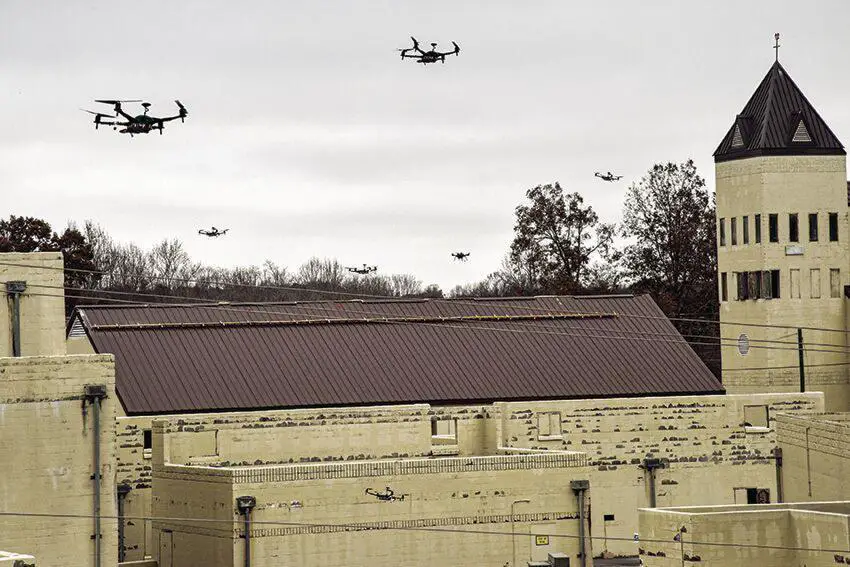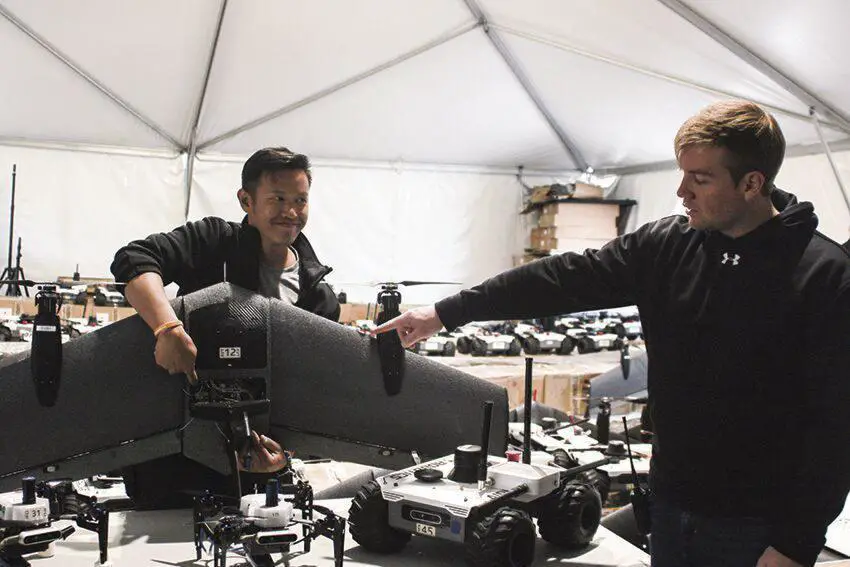The 101st Airborne Division (Air Assault) and its tenant units are at the forefront of warfighter innovation technology, and the installation’s partnership with the Defense Advanced Research Projects Agency is now driving the future of drone development. Fort Campbell hosted the final field experiment for DARPA’s OFFensive Swarm-Enabled Tactics, or OFFSET, program on Nov. 16 at the Cassidy Range Complex, allowing Soldiers and Department of Defense representatives alike to observe and provide feedback on technology which could allow a single service member to operate hundreds of drones at once.
“We are interested in developing very large-scale teams of air and ground robots operating in support of small unit forces in complex urban environments. Large-scale teams could mean hundreds of robots in concert, but I don’t want 100-250 Soldiers or Marines running around with joysticks in their hands, heads down. We would rather be able to orchestrate how these swarms of robots go out with a single operator working alongside a swarm commander. Fort Campbell offers a good balance of the complexity of the environment and access to interesting features. We have everything from multi-story buildings to long corridors and rows of buildings that would really stress test a lot of our robotics systems, and by and large that’s a key element,” said OFFSET program manager Timothy Chung, with DARPA’s Tactical Technology Office.
“If a unit is coming up into a densely populated urban area, they could use a swarm of unmanned aircraft systems to go and do a reconnaissance. Instead of having to send Soldiers in there and spend manpower and other resources, you can send your drones in there to do that reconnaissance and validate threats. To do a reconnaissance of Cassidy would probably take a company plus of Soldiers to do, or a battalion minus. Whereas if this technology is fully developed, one Soldier is all it takes to control the swarm and do the reconnaissance. And one of the future technologies they’re talking about is being able to pair human and swarm teaming and use part of the swarm to breach a door, so if you think there’s a threat in the building you can use them to breach the door instead of a Soldier,” said John Watson, chief, Training Division, Fort Campbell Directorate of Plans, Training, Mobilization and Security.

OFFSET began in 2017 with the vision of discovering and developing technologies to enable advances in collaborative swarm autonomy as well as human-swarm teaming capabilities. During that time, the program has tested its capabilities through field experiments at installations across the country: Camp Roberts, California; Fort Benning, Georgia; Camp Shelby Joint Forces Training Center, Mississippi; Joint Base Lewis-McChord, Washington; and finally, Fort Campbell, Kentucky. DARPA’s research performers have developed both tablet-based and virtual reality interfaces to control drone swarms, and they used them to deploy over 100 robots across Cassidy Range Complex to map out the area and identify a high-value target while avoiding simulated hostiles.
The scenario served as a live demonstration of how Soldiers could use the technology in a deployed environment, from the 101st Abn. Div. to other service branches. OFFSET currently allows teams of drones and rovers to perform dozens of maneuvers using a digital library linked to the operator’s interface. Any number of connected robots can carry out those tasks, which could include surveilling a perimeter or disabling hostile electronic devices, and the goal is to replicate orders a unit commander would give their Soldiers. Feedback is an important step in that process, and stakeholders from the 101st Abn. Div. and the installation’s tenant units were able to take a firsthand look at the technology and see how it could support their operations. DARPA also invited 35 representatives from different backgrounds, agencies and service branches, primarily those working in acquisitions, research and development, to observe the field experiment.
DARPA participation will allow OFFSET to grow in multiple directions as different agencies adopt its foundations. For Brian Black, maneuver support specialist, Armaments Center, U.S. Army Combat Capabilities Development Command, that means finding ways to generate lethality using the technology. Fort Campbell played a key role in that process by connecting OFFSET’s developers with potential users, and Chung said the installation’s central location allowed for a wide variety of attendees. DARPA has not announced a timetable for fielding OFFSET, but the next major step in the program’s development is the Army Expeditionary Warrior Experiment, or AEWE, at Fort Benning. Events like the AEWE are part of a synchronized innovation effort linked with the Army Modernization Strategy, and Watson said Fort Campbell has cultivated strong relationships with agencies like DARPA to achieve the Army’s innovation priorities.
